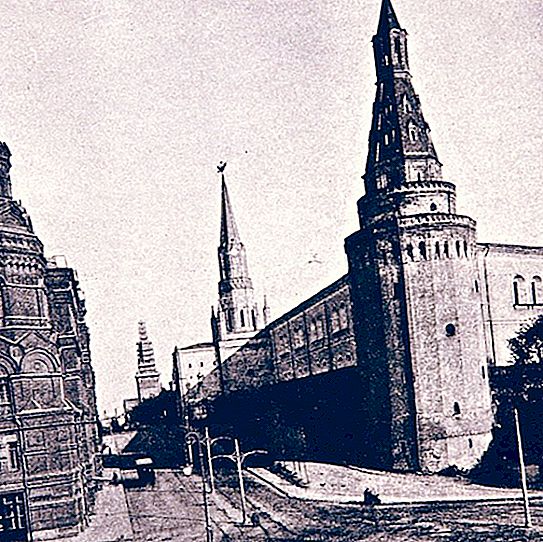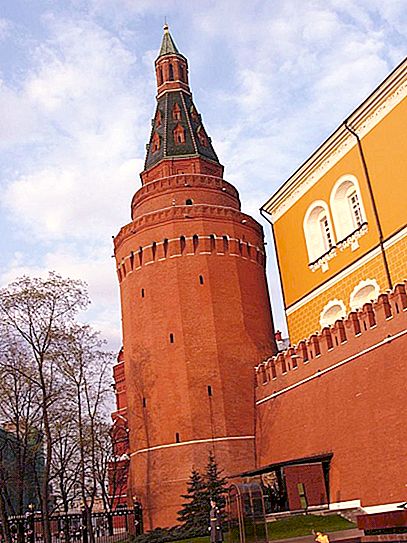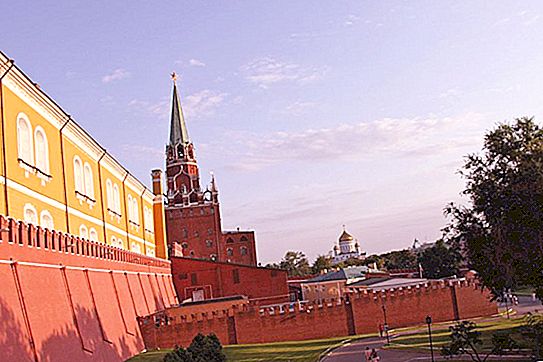The Corner Arsenal Tower, also known as Sobakina or Bolshaya Arsenalnaya, is located in the Moscow Kremlin. It was erected at the end of the 15th century and was the final building in the defense line from the side of Red Square. The construction made it possible to control the crossing to the Trade through the Neglinnaya River. The Kremlin’s Corner Arsenal Tower will be discussed in more detail in the article.
Construction history
Before you begin to describe the Corner Arsenal Tower, you should consider the history of its construction. At the end of the 15th century, the Kremlin’s defensive structures of white stone (hence the name of Moscow white stone) became unusable and dilapidated. Tsar Ivan III the Great ordered the construction of new brick structures.
As the researchers suggest, the construction of fortifications made of new material did not significantly affect the overall appearance and layout, but expanded the Kremlin's territory to the northeast side. Together with the expansion of the Kremlin fortress, it was decided to include a spring on which a powerful Angular Arsenal Tower was erected. Written sources have been preserved that speak of the construction of corner and passage structures (towers).
general description
In 1492, Pietro Antonio Solari, a famous architect of that time, was invited to build new Kremlin buildings from Italy. It was he who created the Corner Arsenal Tower, also known as Sobakina or the "archer with a cache over Neglinna." This refers to the inner well.

This building was erected in accordance with all the rules of fortification of the 15th century and was an independent defense (fortress) building. The tower could withstand the onslaught of enemies, even if the rest of the Kremlin wall was captured by the enemy.
Due to the fact that it was angular, it was the most impregnable and powerful in the ensemble of Kremlin buildings. It should be said that the wall thickness of this tower reaches four meters. On the tiers of the archery, located at the top, it was possible to get only using special ladders, and through a very narrow hole in the arch. However, during the attack there was an opportunity to pull such a ladder up, and then take cover in the tower using a secret underground passage.
Construction device
The Corner Arsenal Tower played a special role among all the defensive structures of the Kremlin. One of the main functions was to protect the crossing of the Neglinnaya River Trading, which was located on Red Square.
The base of the structure was built in the form of a hexagon on a very deep and solid foundation, in which a spring well was hidden. It was necessary to provide everyone in the tower with water in the event of a prolonged siege.

At the top of the structure, mashikuli (mounted loopholes) were created that protruded beyond the edges of the main structure. The tower was crowned with dovetail-shaped teeth, which in the 17th century were replaced by a parapet with the so-called fly widths. Its height is 60 meters.
A tent made of wood with a sentinel tower was erected at the very top of the building. For a rather long period of time, the Corner Arsenal Tower of the Moscow Kremlin stood out from the surrounding landscape of the city.
Improvement
In the construction, there were 7-8 tiers of loopholes, and the window openings were created in the form of a bell so that the warrior inside could stand at full height. The floors of each such tier had wooden floors, which were later replaced by iron and concrete.
In the XV-XVI centuries, an additional wall was added to the Corner Arsenal Tower, which envelops the entire structure in a semicircle. This form was intended for all-round defense and suggested the possibility of conducting flanking and frontal (barrage) fire.
In the period from 1672 to 1686, all the towers of the Kremlin were fortified. At Arsenalnaya, the wooden pitched roof was replaced with an octagonal tent, which had a stepped base. He was crowned with an octagon with a weather vane and a tent. At the very end of the XVII century mashikuli were laid as unnecessary.

In 1707, on the orders of Peter the Great, the Arsenal Tower was expanded and reinforced in order to install new artillery pieces. The foothills were covered with earthen ramparts and five bollards were erected. In 1701, they began to build the arsenal building, which gave the name to the tower itself.




